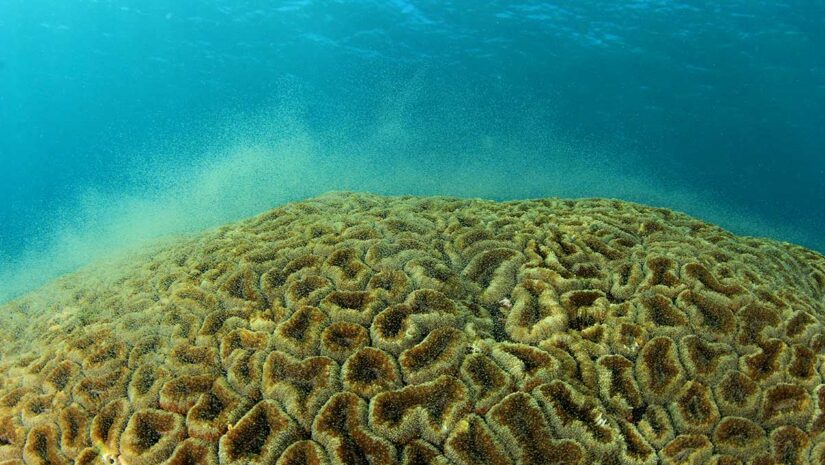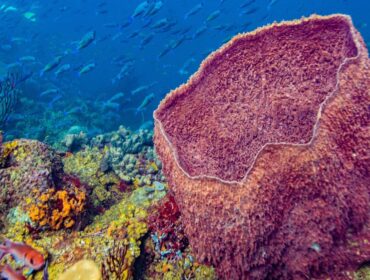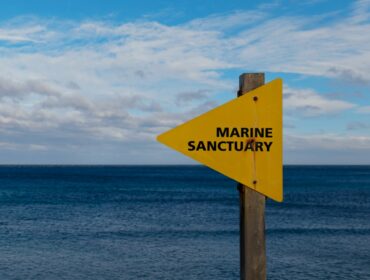Have you ever heard of coral spawning, a spectacular event taking place below the surface? This article will explain what coral spawning is, where you may see it in the world, and why it is critical to preserve the reef. Whether you’re a diver, an environmentalist, or just interested in the undersea world, this article will introduce you to a fascinating and crucial element of our planet’s ecosystem.
What is Coral Spawning?
Coral spawning is a spectacular biological phenomenon where different types of coral species simultaneously release their eggs and sperm into the water. This enormous reproductive event takes place usually once a year and involves a variety of coral species.
Coral spawning is typically tied to a precise combination of water temperature, moon cycles, and daylight hours. Spawning is more common during the warm months, a few days after a full moon, and after sunset. Because predators are less active at these times, the offspring will have the highest chance of surviving.
Specific water temperatures, chemical signals between corals, and certain moonlight wavelengths can all be spawning triggers. Some corals even have the ability to spawn at the same time over long distances.
A coral spawning event includes coral species from the families Acroporidae, Mussidae, and Faviidae, among others. The introduction of multiple species at the same time can increase cross-fertilization and genetic diversity within coral populations.
Coral spawning occurs in numerous coral reefs around the world, but it does not occur simultaneously on a global scale. This is due to the exact environmental signals that trigger the event, which can vary depending on the location and local conditions.
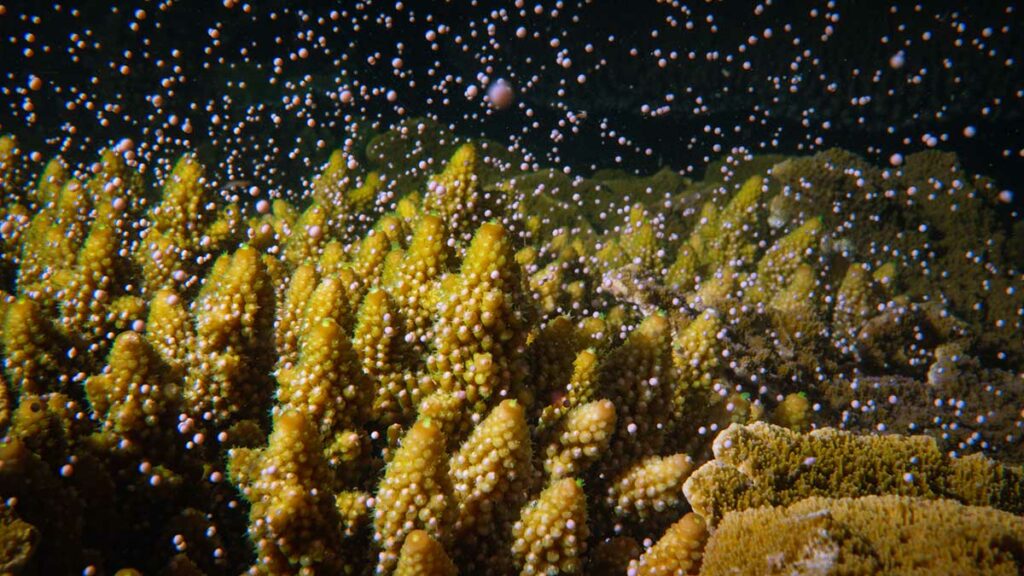
The Magic of Coral Spawning
The magical spectacle of coral spawning is a visually stunning happening that captures the fascination of scuba divers who are fortunate enough to experience it. Coral spawning, also referred to as an “underwater snowstorm”, transforms the sea into a beautiful dance of life.
When corals release their gametes (reproductive cells) into the water, millions of tiny eggs and sperm are set adrift, floating and swirling in the currents. The water becomes filled with delicate, pink, and white bundles, each representing the potential for new life. These bundles rise to the water’s surface, forming ethereal clouds that glow under the moonlit sky.
In the calm of the night, synchronized to each other’s rhythms, the corals suddenly release their reproductive cells, a fantastic sight that only a few have witnessed. The gametes’ gently drifting through the water is a scene of profound beauty and fragility.
Different coral species can generate gametes of varying colors, adding to the visual spectacle. The event is not only captivating, but it is also critical to the life and maintenance of the coral reef. Witnessing coral spawning is like peering into one of nature’s most intimate and magical moments.
The Significance of Coral Spawning
In the context of coral reefs, coral spawning is huge, representing the foundation of reproduction, survival, resilience, and biodiversity within these critical ecosystems.
It’s critical for coral reefs
Coral spawning is essential for the survival and growth of coral reefs. Corals increase the chances of successful fertilization by releasing millions of gametes at the same time into open water. When these gametes are fertilized, they evolve into larvae, which eventually settle on a suitable substrate and mature into new coral polyps. This huge reproductive event ensures that gametes meet and generate new life even amid the immensity of the ocean. Many coral species’ survival would be jeopardized if this coordinated reproduction mechanism did not exist.
It brings diversity to coral
One of the most amazing elements of coral spawning is the contribution it makes to genetic diversity within coral populations. Cross-fertilization between coral species is possible when various coral species release their gametes at the same time. This gene mixing produces new combinations of genetic material, increasing genetic diversity within the population.
Genetic diversity is critical to coral reef resilience, particularly in the face of environmental changes and stressors such as climate change, pollution, and disease. Individuals with features that allow them to survive these challenges are more likely to be found in a more genetically varied community. This diversity functions as a buffer, allowing the population to adapt and survive in changing environments.
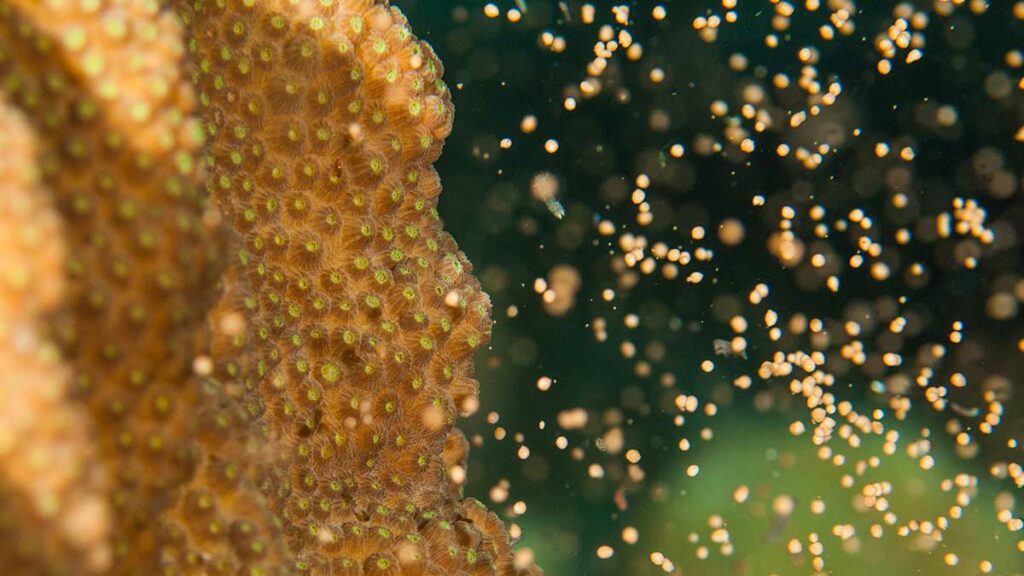
Best Times and Locations for Coral Spawning Dives
Here are some of the best regions and times of the year to observe this fascinating phenomenon.
Great Barrier Reef, Australia
- Best Locations: Cairns and the Whitsundays are popular spots.
- Best Time: Coral spawning often occurs in late October to early December, particularly a few days after the full moon.
- Specifics of the event: Acropora and other corals spawn, creating a “snowstorm” of pink and white gametes, a major event attracting global attention.
Caribbean Sea
- Best Locations: Bonaire, the U.S. Virgin Islands, and Belize are known for coral spawning.
- Best Time: Late August to September, closely tied to the lunar cycle, typically a few days after the full moon.
- Specifics of the event: Species like Montastraea produce yellowish gametes, with many islands participating in this synchronized phenomenon.
Red Sea
- Best Locations: Dive sites in Egypt, such as Marsa Alam, offer opportunities to witness coral spawning.
- Best Time: Late April to early May, particularly during the waning moon phase.
- Specifics of the event: Corals like Pocillopora release pinkish bundles. This is unique due to some species spawning biannually.
Western Australia
- Best Locations: Ningaloo Reef is famous for its coral spawning event.
- Best Time: March to April, usually following the full or new moon.
- Specifics of the event: Spawning includes colorful Acropora and other species, aligning with the full or new moon in a rich marine area.
Florida Keys, USA
- Best Location: The Florida Keys National Marine Sanctuary is a hotspot for coral spawning.
- Best Time: August to September, a few days after the full moon, is ideal.
- Specifics of the event: Featuring species like Montastraea, with pale-colored gametes, well-studied and part of ongoing coral conservation efforts.
Okinawa, Japan
- Best Location: The Kerama Islands and the Sekisei Lagoon offer wonderful dive sites.
- Best Time: Typically, late March to early April, following the full moon.
- Specifics of the event: Various species including Acropora, produce a mix of colors, reflecting the area’s high biodiversity.
Thailand
- Best Location: The Similan Islands and the Andaman Sea are renowned for their coral reefs.
- Best Time: April to May, usually after the full moon, offers the best chances to witness coral spawning.
- Specifics of the event: Diverse species like Pocillopora spawn in the Similan Islands, offering a colorful spectacle in well-protected marine parks.
Palau
- Best Location: Various sites around the islands of Palau.
- Best Time: March to April is the typical spawning season.
- Specifics of the event: Different coral types such as Acropora and Montipora produce an array of colors in the clear, nutrient-rich waters of Palau.
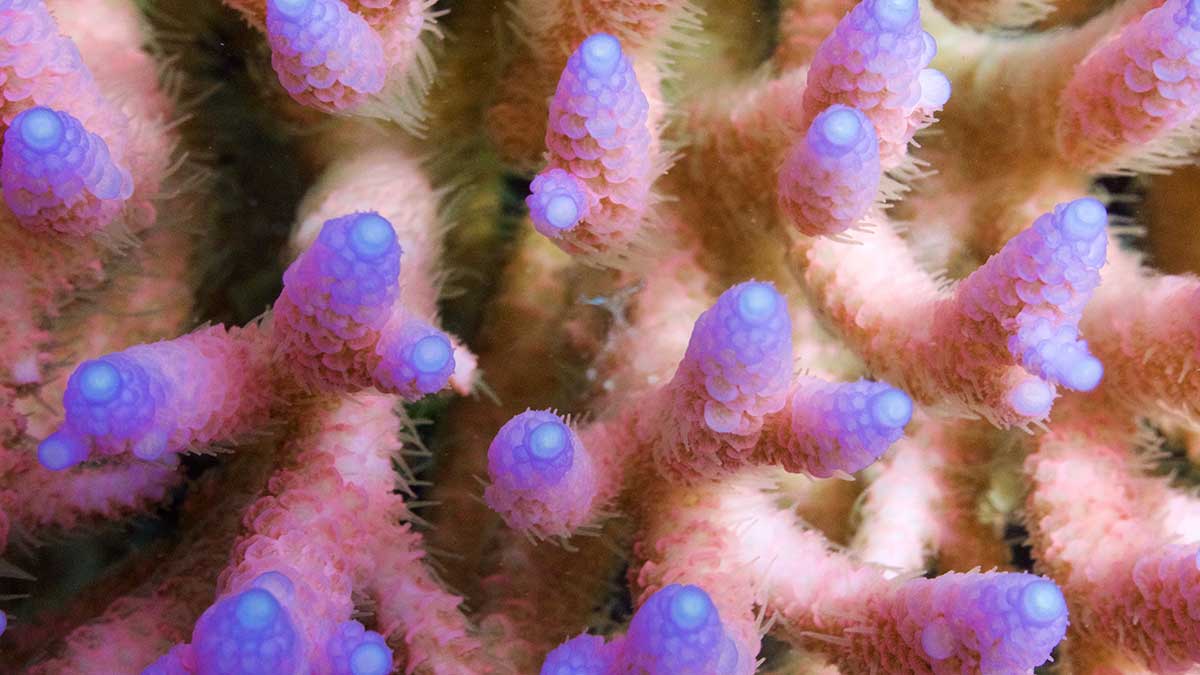
Responsible Diving During Coral Spawning
Due to the delicate nature of corals, safe diving activities are required to ensure that the coral spawning continues unabated. Corals are especially sensitive during the spawning process. Any unwanted disruption or physical contact might stress these organisms, impairing their ability to successfully release gametes and, as a result, potentially damaging the future generation of coral reefs.
Responsible diving practices during coral spawning include:
Avoid Physical Contact
Touching or brushing against corals can cause physical damage. Divers must maintain a good buoyancy and keep a safe distance.
Minimize Light Pollution
Excessive artificial lighting may disrupt the coral’s natural spawning signals. Use lights cautiously.
Follow Local Guidelines
Dive operators in spawning areas are often well-versed in best practices and timing. Following their guidelines ensures minimal disruption.
Educate Yourself
Understanding the significance of coral spawning and the sensitivity of the corals during this time promotes a more mindful interaction with the marine environment.
By adhering to responsible diving practices, divers can contribute to the continued health of coral reefs worldwide. Witnessing the coral spawning becomes not just a visual spectacle but an opportunity to engage with nature in a manner that sustains and nurtures it.
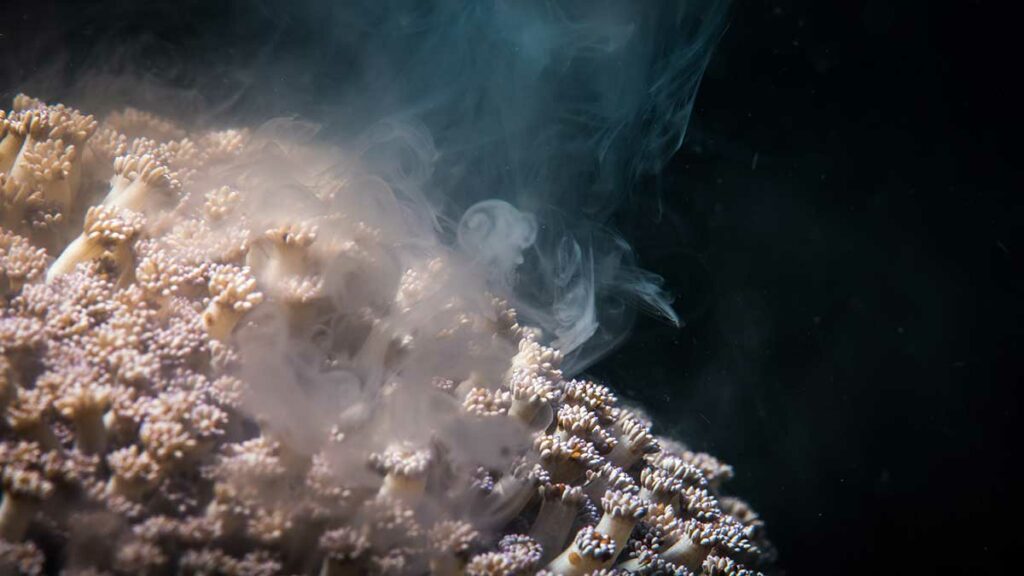
Capturing Coral Spawning Through Photography
Photographing the shimmering beauty of coral spawning is an exciting but difficult task. While attempting to capture stunning photographs, underwater photographers must be mindful of the fragile environment. Here are some tips and tactics to help you get there:
Know the Timing
To be at the correct place at the right time, research the particular time and location of spawning events. For accurate information, consult with local dive operators.
Use Appropriate Gear
To photograph close-up details without disturbing the corals, use underwater camera housing and consider macro lenses.
Consider Your Lighting
While proper lighting is necessary to reveal the colors and nuances, it is critical not to over-illuminate and upset the corals. Use a diffuser and low-angle lighting techniques if possible.
Maintain Proper Buoyancy
Maintaining proper buoyancy allows you to position yourself without touching or hurting the coral. Prepare by practicing your diving skills.
Capture Different Perspectives
Try various angles and compositions, including wide-angle shots to illustrate the scope of the event and close-ups to capture the intricate details.
Be Ethical and Respectful
Put the coral’s well-being ahead of capturing the ideal shot. Follow ethical diving procedures and local regulations.
Underwater photographers may create magnificent photographs of coral spawning by combining technical expertise, artistic vision, and environmental responsibility. These photographs not only capture a moment in time, but they also aid in research.
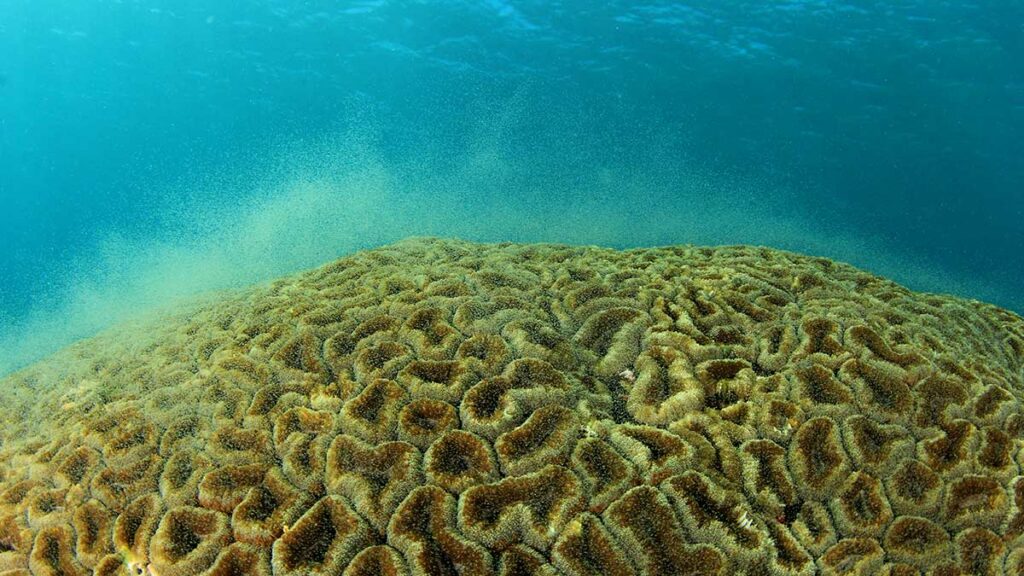
Supporting Coral Conservation
Coral reefs, the “rainforests of the sea,” are facing severe dangers. Climate change causes coral bleaching and ocean acidification, both of which have an impact on growth and vitality. Pollution from agricultural and coastal development suffocates the reefs, while overfishing and harmful fishing methods undermine the ecology. Even reckless tourism contributes to the deterioration.
Marine protected areas, sustainable fishing, responsible tourist norms, restoration initiatives, and awareness and education are all necessary answers to these concerns. Coral conservation is not only important ecologically; it is also important economically and socially, as many people rely on healthy coral reefs for their livelihoods, food, and coastal protection. A commitment to protecting these amazing ecosystems is critical for the existence and flourishing of our global ecology.
Conclusion
Coral spawning events are first and foremost incredibly important for coral reef conservation, but they also provide a magical display that is truly a once-in-a-lifetime experience. Scuba divers should take advantage of the opportunity to observe such a beautiful event, as it transforms ordinary diving experiences into something nearly bizarre. The coordinated discharge of colorful gametes, the underwater “snowstorm,” and the sense that you are a part of a key moment in the reef’s existence make it an incomparable adventure.

